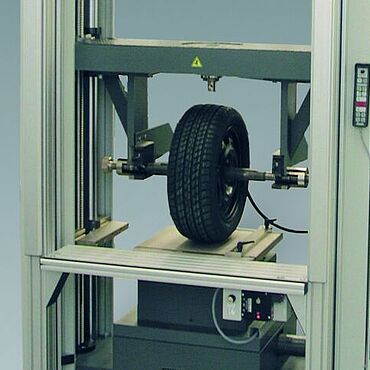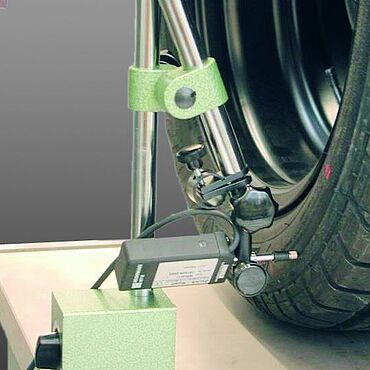Testing of Wheels, Rims, and Tires
In the automotive sector, wheels are made of steel, light metal, or composite materials and their tires. Tires are complex composite bodies composed of materials with various physical properties. ZwickRoell testing systems are used to determine the quasi-static and dynamic properties of wheels, rims, and tires. This ranges from standard tests on rubber, textiles, and wires to tests on the entire wheel/rim/tire system.
Learn more about our solutions for
Tires Rims Wheels Disc brake pads Request a consultation Downloads
Testing of tire components
Tire testing presents particular challenges due to the complex material composition of tires. Tires consist of a combination of rubber compounds (made of natural or synthetic rubber, carbon black, and various additives) and embedded fabric inserts (reinforcement made of steel or textile cord). The combination of these materials leads to anisotropic behavior, especially under mechanical stress.
The different materials and their interactions require specific test methods to determine properties such as tensile strength, delamination behavior, and rheological properties. The following tests, among others, are performed at ambient and typical environmental temperatures from -70 to +250°C:
- Tensile tests to ISO 37 and ASTM D412 and tear growth tests to ISO 34 and ASTM D624 on elastomers using various specimen shapes
- Hardness, rebound, and abrasion tests on elastomers
- Abrasion tests on steel and textile cords made of elastomer bearings
- Tensile tests on steel- and textile cords Automated specimen feeding due to the large specimen quantities during the development of new compounds
- Determination of viscoelastic properties
Stiffness of automobile tires under variable tire pressure
The stiffness of automobile tires is determined by measuring the force ratios under vertical and horizontal loads as well as variable tire pressure.
For this, we would use a 50 kN AllroundLine materials testing machine with a horizontal linear unit and a multi-component force measuring platform on the lower base crosshead. Using the respective test program within the testXpert testing software, you can perform the desired tests under vertical and horizontal load application with varied tire pressure and then evaluate them.
Testing axial deformations of the rim flange
To determine stiffness properties, compression tests are performed on the rim flange with a special pressure mandrel. A floor-standing testing machine with a forward projecting, height-adjustable T-slot crosshead is used for this purpose. This allows the rims to be placed and fixed at an ergonomically comfortable height in the test area. The load cell ensures exact measurement of the axial force, even if lateral forces occur due to the geometric shape of the rim. Due to its special design and placement, the load cell can be inserted into the upper and lower test area of the machine for measurements.
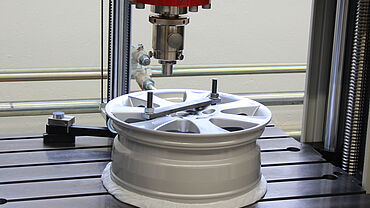
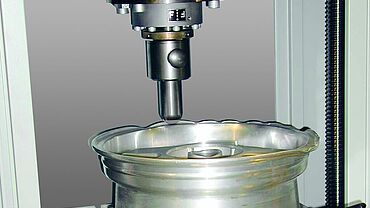
Determination of full-surface deformations on lightweight rim
When determining full-surface deformations on a lightweight rim, the axial or radial axle load is variably applied by an electromechanical testing actuator and the deformation behavior is recorded using an optical 3D deformation measuring system. The strain results provide information about possible weak points in the component.
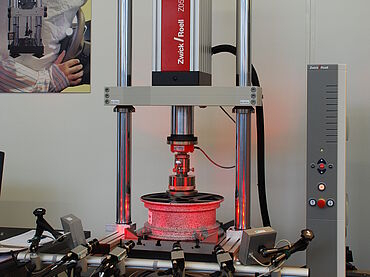
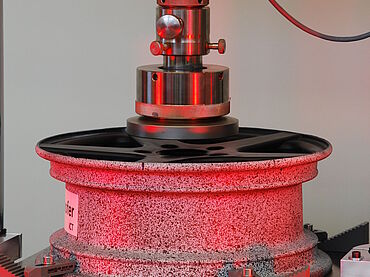
Hardness testing on aluminum rims
Rims are subject to high mechanical and thermal loads during driving, which require high strength and fatigue resistance of the material. The material properties of aluminum rims are significantly influenced by the alloy composition, the manufacturing process (e.g. low-pressure casting, forging) and thermomechanical post-treatment.
Hardness testing is used as a non-destructive test method to characterize the material properties achieved. It is used to ensure consistent mechanical properties across different batches and production lots. In practice, the Brinell hardness test method according to ISO 6506 or ASTM E10 (e.g. HBW 2.5/62.5) is primarily used, especially for testing highly stressed areas such as the rim well, spoke structure, and the wheel center or wheel mounting flange.
The Vickers method to ISO 6507 can also be used to examine the homogeneity and indentation depth of the heat treatment and to determine hardness curves. Depending on the test environment, testing is performed manually during production monitoring or automatically as part of inline-capable testing systems.
For comprehensive hardness testing of wheels, ZwickRoell’s universal hardness tester VisionLine is the optimal choice.
Testing of disc brake pads
Disc brake pads are one of the most important parts of a wheel brake. In order to evaluate the quality of the pads, the change in pad thickness is determined, among other factors, through one dimensional compression loading in the direction normal to the friction surface of the disc brake pads.
To handle this task, ZwickRoellmaterials testing machines are equipped with a compression test kit featuring an integrated measuring system. The deformation is measured via three measuring transducers that are positioned at a 120° offset on a pitch circle. Pressure is applied via an adapted piston replacement compression piece with circular force application. The compression piece's flexible suspension assembly allows exact parallel placement on the disc brake pad, ensuring a completely uniform and homogeneous application of pressure. The testing position of the compression die runs through the center axis of the disc brake pad's center of area. The test kit is suitable for both one-piece and divided disc brake pads.
Hardness testing of brake discs
Brake discs are safety-critical components in the chassis system and are subjected to extreme thermal and mechanical loads during operation. In order to ensure stable friction behavior, low susceptibility to cracking and sufficient wear resistance, cast alloys (GJL) or composite materials (e.g. cast-aluminum hybrids or CMCs) are predominantly used in series production.
Hardness testing is used as a non-destructive test method to check the material quality of brake discs:
- For cast brake discs, the Brinell method in accordance with ISO 6506 is the established standard procedure. The tests are carried out primarily in the friction ring and hub area of the disc. Typical test loads range from HBW 2.5/187.5 to HBW 10/3000, depending on material thickness, material structure, and specification. In addition, the Vickers method in accordance with ISO 6507 is used to assess the pearlitic lamellar structure in order to draw conclusions about the wear resistance of the brake discs.
- In the case of coated or heat-treated brake discs, such as high-carbon cast iron or laser-hardened variants, the Vickers method according to ISO 6507 can also be used to assess the pearlitic lamellar structure in order to draw conclusions about the wear resistance of the material.
- OEM specifications and industry-specific standards such as SAE J431 (for gray cast iron) or internal company standards define the permissible hardness ranges and the method of implementation. In series production, testing is usually carried out manually or semi-automatically, but in high-volume applications it is increasingly being integrated inline as part of digital process controls.
For comprehensive hardness testing of brake discs, ZwickRoell’s universal hardness tester VisionLine is the ideal choice.



